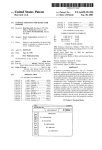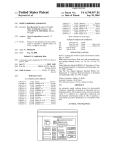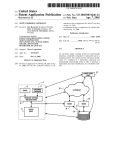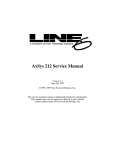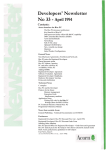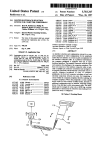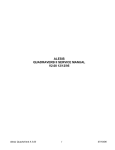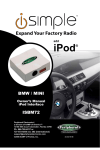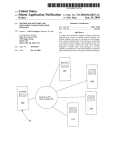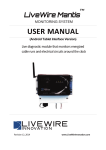Download STATUS INDICATOR @ lsglggliY IE
Transcript
US 20030023703A1 (19) United States (12) Patent Application Publication (10) Pub. No.: US 2003/0023703 A1 (43) Pub. Date: HAYWARD et al. (54) CONTEXT SENSITIVE WEB-BASED USER Jan. 30, 2003 Publication Classi?cation SUPPORT (76) Inventors: KEN HAYWARD, BROCKPORT, NY (US); MARC J. KROLCZYK, ROCHESTER, NY (US); DAWN M. MARCHIONDA, MARION, NY (US) Correspondence Address: PATENT DOCUMENTATION CENTER XEROX CORPORATION 100 CLINTON AVENUE SOUTH Notice: Im. c1? . G06F 15/16 Us. 01. ............................................................ ..709/217 (57) ABSTRACT A method of providing support to a user of a computer peripheral includes sensing a peripheral indicia at a com puter and registering the peripheral and downloading from a server additional information about the peripheral based on the peripheral indicia. The peripheral indicia includes any of a model number, a part number, a serial number, a date of XEROX SQUARE-20A ROCHESTER, NY 14644 (US) (*) (51) (52) manufacturer and a con?guration indicia. Registering the peripheral is performed by launching a communications This is a publication of a continued pros broWser to connect to the server. The method also senses a ecution application (CPA) ?led under 37 peripheral condition at the computer Where the peripheral condition includes either an error code or a code indicative CFR 1.53(d). (21) Appl. No.: 09/397,125 of a consumable reaching a predetermined threshold or both. This method accesses the server at an address de?ned by the (22) Filed: Sep. 16, 1999 peripheral condition, and the server provides the broWser With additional information about the peripheral condition. TITLE I; IE TO FILE EDIT VIEW HELP STATUS INDICATOR HOME DESK @ lsglggliY IE SERVICE NAME [:I SYSTEM SETTINGS TOP SCAN D ON-LINE HELP [:1 ORDER SUPPLIES FAX E] USER GUIDE COPY m GUIDED TOUR PRINT ¥ J Patent Application Publication Jan. 30, 2003 Sheet 1 0f 6 US 2003/0023703 A1 '~ "5 . <1: G “ “*A I '3 Q: r ______________________ __ QI N 11 yr: ' u I \Eg | I ________ _ 5.5-) E“ | I l a I z | g ' “.5 1 I I I I I I I I 2 4-611» < g —->zz Go I I 1 E ,\ _ ‘1| I a: a: | c w I ,\ % 2 —> | \_ I 32 N l_ —__ l 1 R? _ \ E a] I ' _____ __J | ' I I I | Patent Application Publication Jan. 30, 2003 Sheet 2 0f 6 US 2003/0023703 A1 FIG.2 FWIARME HANDLER Patent Application Publication Jan. 30, 2003 Sheet 3 0f 6 US 2003/0023703 A1 \ 325® @ wz a 1 ES_“0:6E5 02 \5LEMWIU 5 #%23: Uw“z:E-z:o U 1 3 9 8 0 U 3 5 0 1 m : wUz?n ao U3woED5zEma 5mEm>5m=:> is zsm E :8 25 Patent Application Publication Jan. 30, 2003 Sheet 5 0f 6 5" ”\ SENSE m s12 I REGISTER \— PERIPHERAL 513 US 2003/0023703 A1 ? / FIG 5 I’ \ DOWNLOAD PERIPHERAL INFORMATION 52' SENSE PERIPHERAL \ 522 couomou IS INFORMATION IN MEMORY? \ LAUN€H BROWSER 5”\ I STORE INFORMATION IN MEMORY I \ RETRIEVE INFORMATION ‘ FROM MEMORY $26 \ YES NO 523 $25 A/ Si I DISPLAY INFORMATION FIG. 6 Patent Application Publication S3] \ s32 \ Jan. 30, 2003 Sheet 6 0f 6 SENSE PERIPHERAL INDICIA ‘L SENSE PERIPHERAL CONDITION 533 J, K‘ LAUNEH BROWSER \ DISPLAY PURCHASE ORDER 535 \ J, COMPLETE PERSONAL mm 536 \ J, SEND PURCHASE ORDER FIG. 7 US 2003/0023703 A1 S3 ’/ _ Jan. 30, 2003 US 2003/0023703 A1 CONTEXT SENSITIVE WEB-BASED USER SUPPORT 16 reads the state of the machine and forms an error code number. Code handler 22 of user interface 20 receives the BACKGROUND OF THE INVENTION error code and causes it to be displayed on status monitor 24 of user interface 20. [0001] 1. Field of the Invention [0002] The present invention relates to Web based user support for a computer peripheral. In particular, the inven tion relates to a computer program that responses to a particulariZed sensed condition in a peripheral by accessing a corresponding particulariZed URL (universal resource locator) address. [0003] 2. Description of Related Art [0004] Personal computers and their peripherals are noW affordable to small offices and home of?ces (SOHO) result SUMMARY OF THE INVENTION [0009] It is an object to the present invention to provide enhanced user support information. It is a further object of the present invention to automatically access the enhanced user support information using a server address de?ned by a peripheral indicia and by a peripheral condition. [0010] These and other objects are achieved in a method that provides support to a user of a computer peripheral that includes sensing a peripheral indicia and a peripheral con dition at a computer and registering the peripheral and ing in a large number of computers and computer peripherals doWnloading from a server additional information about the installed at diverse locations. The operators of these SOHO peripheral based on the peripheral indicia and the peripheral computers, in general are less experienced in the repair and maintenance of computers and peripherals than they are in the practice their particular trade or business (e.g., carpet installer, accountant, etc). Therefore, many manufacturers of computers and peripherals provide toll free “hot line” tele phone numbers (e.g., 800 numbers) so a SOHO computer condition. The peripheral indicia includes any of a model number, a part number, a serial number, a date of manufac turer and a con?guration indicia and the peripheral condition includes either an error code or a code indicative of a operator can call for help. This is an economic burden on the manufacturer. communications broWser to connect to the server. This method accesses the server at an address de?ned by the [0005] Manufacturers typically maintain a database of information to support the repair and maintenance of their products. ASOHO computer operator, or even a professional computer technician, can call a help line to speak to an operator that accesses the database to ansWer particulariZed questions (e.g., “hoW do I change an ink cartridge?”). Manufacturers have prepared user friendly computer inter faces so their help line operators can easily access the requested information (e.g., by product type, detected error condition, etc.). [0006] Some manufactures have built their database in an HTML format (hypertext markup language format) that may consumable reaching a predetermined threshold or both. Registering the peripheral is performed by launching a peripheral condition, and the server provides the broWser With additional information about the peripheral condition. BRIEF DESCRIPTION OF DRAWINGS [0011] The invention Will be described in detail in the folloWing description of preferred embodiments With refer ence to the folloWing ?gures Wherein: [0012] FIG. 1 is a block diagram of a user interface of a knoWn computer peripheral; [0013] FIG. 2 is a block diagram of a user support system according to the present invention; be accessed over the Internet by a broWser in a computer. [0014] HTML is a format that is Widely used to present information at Internet Web sites. HoWever, ?nding the correct HTML formatted page still requires a skilled operator. Some Web embodiment of the invention; [0015] FIG. 3 is a vieW of a “home” screen display of an FIG. 4 is a vieW of a “status WindoW” of a screen display of an embodiment of the invention; sites are designed With better navigation aids (i.e., linking “buttons”) than other sites. HoWever, a minimum familiarity With Web pages and links is still required. [0016] [0007] KnoWn computer peripherals (e.g., a combination fax, copier, printer and scanner Workstation) provide some update process of the invention; and user assistance as part of the peripheral itself At a minimum, the peripheral Will have some lights (e.g., light emitting diodes knoWn as LEDs or equivalent) that indicates one or more error conditions). More common is a small LCD (liquid crystal display) that indicates a Wider variety of error conditions. Typically, a user reads an error code from the LCD, looks up the error code in a peripheral user’s manual, and then calls the manufacturer’s toll free help line for an FIG. 5 is a How chart of a registration process of the invention; [0017] FIG. 6 is a How chart of a user support information [0018] FIG. 7 is a How chart of a online purchase order process of the invention. DETAILED DESCRIPTION OF PREFERRED EMBODIMENTS [0019] In FIG. 2, SOHO computer 30 includes modem 34 to convert computer binary information to analog telephone explanation of the code or instructions on What to do to ?x signals. In this Way the SOHO user may be connected to the problem. Internet 36. Computer 30 has installed and operating thereon [0008] FIG. 1 depicts a typical knoWn peripheral 10 connected to a knoWn computer 30 over a bus 32. Peripheral 10 includes sensors 12 to detect conditions (e.g., paper tray empty). Sensors 12 and machine state ?ags 14 (e.g., Warm up or not ready) describe the state of the machine. FirmWare an Internet broWser (i.e., a softWare module that runs on the SOHO computer to interface the user to the Internet). [0020] Internet 30, as depicted in FIG. 2, is any suitable communications system. Presently, Internet access services are often provided by Internet Service Providers (ISPs). Jan. 30, 2003 US 2003/0023703 A1 Typically, an ISP maintains a point of presence (POP) in the user’s local telephone system to give the user a local telephone number to call. In this case, modem 30 is a telephone modem, and under user control the broWser causes modem 34 to place a call to the POP. The POP is linked to the IPS’s main service center by trunk lines in one form or another. The ISP’s main service center has a bank of modems (not shoWn) to reconvert the analog telephone signals into computer binary information, and a computer (also not shoWn) in one form or another to connect to the Internet backbone (a digital or binary communications sys tem, also not speci?cally shoWn). The Internet backbone includes an Internet pier (i.e., terminal) Where properly formatted digital signals from the ISPs main service center are launched onto the Internet backbone. The user, through his broWser, may access any site on the Internet based on a [0026] Then the process of registering the peripheral (step S12, FIG. 5) launches a communications broWser to connect to the registration server. The registration page is displayed on the screen and the user ?lls out the information ?elds (e.g., the user name) and clicks on the send button. The user ?lled out ?elds and the exact peripheral indicia are sent to the registration server. This results in a precise con?guration and date of the registered product being stored on the registration server. [0027] At the end of online registration process S1, a ?le of additional information directed to the registered periph eral is doWnloaded from the server. The doWnloaded infor mation is dependent on the peripheral indicia. In this Way the latest information on the registered peripheral may be stored in computer 30, and the information is directed to the precise URL. Everything from the POP to the Internet backbone is con?guration and date of the registered product. covered by the representation of Internet 30 in FIG. 2. [0021] Other communications protocols may be used and are equivalent. For example, ISDN (integrated services [0028] At product launch, the manufacture prepares user support information in either printed form to ship With the digital netWork) is a Widely used high speed communication protocol. DSL (digital subscriber line) is a neWer protocol that is still groWing in acceptance. Cable telephone systems are establishing special “cable modems” as an alternative to a telephone modem A cable modem communicates With a headend of a cable system Where the communication is routed through a trunk to an Internet pier, either directly or product or in an electronic data ?le to be installed With the installation softWare to be later accessed from a help menu. In either case, the manufacturer uses its best judgement of What information is needed by the users. There is a balance betWeen providing too much information (taking up memory space or requiring big printed books) and too little informa tion making it necessary for a user to call the manufacturer’s help line too often. indirectly through an ISP. These or other protocols may be used to link modem 34 (FIG. 2) to the Internet. users ask questions after product launch. The manufacture [0022] Separate and apart from the Internet, a peripheral tracks the help line inquires and prepares a list of frequently [0029] Even With the best judgement at product launch, manufacturer oWns or leases server 40 connected to the asked questions With their ansWers. HoWever, the manufac Internet through modem 38. Modem 38 connects to the Internet either directly or indirectly through an ISP. Server 40 performs a variety of functions for the manufacturer from registering a neW purchaser of a peripheral to publishing turer needs an ef?cient Way to published this information to the registered users in a timely manner. After many months or years of sales of a successful peripheral product, the information about the peripheral. become quite large. [0023] A peripheral (e.g., a combination fax, copier, printer and scanner Workstation) is sold to the user With installation softWare. The user physically connects periph eral 10 to computer 30, then loads and executes the instal lation softWare. The installation softWare loads on the com puter an application program that may be executed directly by the user to perform tasks With the peripheral, and one or more driver modules (e.g., a printer driver) that may be executed by another application program (e.g., a Word processor) to perform tasks for the, for example, Word frequently asked questions or other support information may [0030] Some of this information may be published on an Internet Web site, but this means the information is broad casted to the general public as Well as neW and old customers Who bought the peripheral but With different con?gurations. Potential neW customers Will need only information about the most recent con?guration of the product, although sup port could be provided for a used equipment market. Cus tomers Who recently bought the peripheral Will have an updated product that Will not need access to some or all of processor. the frequently asked questions that apply to older versions of the peripheral. Many customers Who are buying a product [0024] The installation softWare may include and execute a module to perform online registration. Online registration under a stable product name may not be aWare that there systems use a registration server at the manufacturer’s plant to provide the user With HTML formatted pages over the Internet for display on computer 30. These pages include blank ?elds to be ?lled out by the user. For example the ?elds may require the user’s name and the product name and model. The HTML formatted page also includes a “send button” to be “clicked on” by the user to send the ?lled out ?elds to the registration server in order to complete the online registration. [0025] Uniquely, the present invention senses a peripheral indicia at computer 30 (step S11 of FIG. 5). The indicia may be revisions and upgrades made to the product during the product cycle, and that there is often a signi?cant con?guration evolution during the product’s life cycle. A single Web site for the product by product name does not address these con?guration changes during the product’s life cycle. [0031] HoWever, using the present invention, the speci?c peripheral indicia is used to identify the speci?c user support information that is useful to the operation and maintenance of the particular peripheral having the particular serial number or con?guration. includes any of a model or part number, a date of manufac ture, a serial number and even con?guration information for [0032] Even so, after the initial registration of the periph eral, the user support information (e.g., frequently asked peripherals that may have diverse recon?gurable parts. questions) may be ampli?ed. For example, early in the Jan. 30, 2003 US 2003/0023703 A1 product’s life cycle, an unanticipated and large number of from home screen (or any other screen), the status WindoW calls may be received on the toll free help line dealing With a particular issue. Help line operators respond to the user inquiries, and report the issue to persons Who maintain databases for user support. A person maintaining the data appears. The top of the status WindoW includes tWo areas in the upper half: an icon display of the peripheral so the user bases may add one or more frequently asked questions and reply. In this Way the user support information continues to button betWeen. As depicted in FIG. 4, a peripheral condi tion is indicated by the X, the condition explained as a “Magenta Ink Level LoW” condition, and tWo options are evolve throughout the product’s life cycle. [0033] The present invention permits a user to update the user support information stored in computer 30 at any time. Using the peripheral indicia ensures that only the support information needed to support the particular product is doWnloaded from the manufacturer’s server (40, FIG. 2). [0034] During the operation of the peripheral, error con ditions may occur or peripheral conditions may occur that indicate a need to replace a consumable (e.g., paper tray empty, or out of ink). Aperipheral condition is derived from has a comfort feeling that the status is about his peripheral and a peripheral condition sub-WindoW With a “shoW me” given. The ?rst option is ordering another magenta ink cartridge using the “Buy NoW” button, and the second option is replacing the cartridge using the “ShoW Me” button. [0039] The bottom of the status WindoW includes three areas in the loWer half: a job status sub-WindoW, an ink level sub-WindoW With a “Buy NoW” button, and three miscella neous buttons (system settings as a short cut to change settings, maintenance button to access a diagnostics screen and a close button). The job status sub-WindoW shoWs three sensors 12 and machine state 14 in ?rmWare 16. The peripheral condition is sent by ?rmWare 16 over bus 32 to an jobs as an example, shoWing the portion completed. Pref application program running in computer 30. The applica be displayed under the portion completed. Next to each job tions program Will indicate the condition to the computer user, for example With an X on the display screen. [0035] FIG. 3 depicts a generaliZed display screen for the erably, some indicia of the job, such as a ?le name, Would is a cancel button to permit the user to optionally cancel the job. [0040] It should be appreciated that the screens depicted in exemplary combination fax, copier, printer, scanner Work station. Along the top line is the title of the application FIGS. 3 and 4 are representive of a best mode of the screen embodiments, but these screen formats do not limit in any program, for example, “SOHO WorkStation”. The next line is a knoWn type of drop doWn menu bar. The next line Way the invention de?ned by claims. includes information speci?c to the present exemplary Work station. The ?rst three lines are common to all screen displays of the application program. The third line, for example, includes an X indicator to indicate that a status condition has occurred that should be revieWed, and a Status Inquiry box With “button” to “click on” and get more status information. On the left hand side is a vertical bar With six buttons that is referred to as a service panel and it appears in most of the screens of the application program. The remaining portion of the screen is a Work area that is context sensitive and dependent on the selected service. [0036] In the service panel there are six buttons. The ?rst button alWays returns to the home menu screen. The next button accesses a “desktop” directory for use by the present application. The next four buttons, in succession, access the scanner screen, the fax screen, the copier screen and the printer screen. [0037] Five menu choices are depicted in the context sensitive Work area of the home screen. The ?rst menu entry accesses a screen to revieW or modify system settings. The system setting screen provides for setting up all device settings that Would otherWise need to set up With hard buttons, and preferably includes a link to maintenance and print driver setup screens. The second menu entry in the home screen accesses a screen to access toll free online help services and user support as described further herein. The third menu entry of the home screen accesses a screen to order supplies and/or upgrades from the manufacturer or an manufacturer approved supplier. The fourth menu entry of the home screen accesses a digital user manual With hyper linked information and help ?les. The ?fth menu entry in the home screen accesses a simpli?ed guided tour and interac tive demonstration of the peripheral’s operation. [0038] FIG. 4 depicts the Work area (i.e., status WindoW) of the status screen. When the status inquiry button is clicked [0041] When a user accesses the status WindoW and clicks the “shoW me” button, the application program Will access replacement instruction information related to replacing the magenta ink cartridge. FIG. 6 depicts this shoW me process as step S2. In step S21, the application program senses the particular peripheral condition. The application program running in computer 30 receives the peripheral condition over bus 32 from ?rmWare 16 (FIG. 2). In step S22 (FIG. 6), the application program checks to see if the information is already present in the memory of computer 30. If the information is not present, the application program in step S23 launches an embedded or an external communications broWser to access the manufacturer’s server at an address de?ned by the peripheral condition. For example, the address might be: [0042] WWW.manufacturer.com/product/xxx, [0043] Where “product” is the peripheral indicia or some thing derivative therefrom, and “xxx” is the peripheral condition (i.e., magenta ink level loW) or something deriva tive therefrom. [0044] The broWser accesses a Web page on the manufac turer’s server that is identi?ed by “/product/xxx”. In this Way the information provided is not only speci?c to the product con?guration of the peripheral as it exist in the product’s life cycle, but is also speci?c to the particular peripheral con dition sensed. Then, the server provides the broWser With additional information about the peripheral condition Which is stored temporarily in the computer’s memory (step S24, FIG. 6). The additional information may be text, but pref erably includes illustrations and even photographs. It may include audio clips (e.g., using .Wav format) and it may include video segments using any of the available formats. A goal is to make it look to the user as if a technician on the other side of the computer screen is shoWing the user hoW to replace the magenta cartridge in the user’s speci?c machine. Jan. 30, 2003 US 2003/0023703 A1 [0045] Audio and video clips require large storage areas. any of several self diagnostic routines. The installation While it may be possible to store in the computer’s memory a complete audio and video clip for several conditions, it is softWare installs a diagnostic module that is more or less and unlikely that all possible conditions Will be economically part of the machine. The speci?c diagnotic options depends storable in the computer’s memory. HoWever the manufac turer’s server, server 40 in FIG. 2, is much larger and may on the speci?c con?guration of the peripheral and are include clips for all possible conditions, for each con?gu ration of each product line that is supported. help information is doWnloaded. The present invention bene?ts from the use of the peripheral indicia and peripheral [0046] executive that calls very speci?c sub-modules to test each doWnloaded from server 40 in the exact same manner as user an area that is to be used to save the most frequently used condition to specify a URL address that exactly matches the user’s peripheral and condition. In this Way, diagnostics may be performed quicker. Then, When a failed part is isolated, the “buy noW” button appears and a replacement part may be shoW me ?les. For example, a memory area large enough to store 10 average siZed shoW me ?les may be reserved in the the “shoW me” button to see hoW to replace the part When computer’s memory (e.g., a disk memory). A criteria for the part arrives. In step S25, the additional information is retrieved from memory and in step S26 displayed to the user. It should be appreciated that the memory of computer 30 may include ordered immediately as discussed beloW. The user may use managing this memory area is established to ?ll the memory area When there is suf?cient space for a neW shoW me ?le, and to delete past shoW me ?les to make room for a neW [0051] When a user clicks on the “buy noW” button, either from FIG. 4 or from a maintenance screen, the application shoW me ?le When needed. program enters purchase order sequence S3 (FIG. 7). In FIG. 7, When the buy noW button is clicked, the application program has already sensed the peripheral indicia S31 (as in S11, FIG. 5) and the peripheral condition S32 (as in S21, FIG. 6). Then at S33, the application program launches a [0047] Since the provision of “timely” user support infor mation is one of the bene?ts of the present invention, a preferred criteria for selecting a ?le to delete is to delete stale user support information. Stale may de?ned by the differ broWser to access a purchase order page or screen from the ence betWeen the current date (from the operating system) manufacturer’s server 40 based on the peripheral indicia and and the date of the information ?le stored in the memory area (from the ?le entry in the appropriate directory or the detected peripheral condition. The purchase order screen is automatically partially ?lled out at server 40 With the part folder). For example, it may be acceptable to delete any number to be ordered based on the peripheral indicia and condition. At S34, the broWser displays the screen to the user. At S35, the user selects such online purchasing options as method of shipment, payment on account or by credit card, etc. For example, the user may enter a credit card doWnloaded user support ?le that is over one year old. The threshold for deletion may vary during the product cycle. For example, at product launch, any ?le over tWo Weeks old may be regarded as stale, and a year after product launch any ?le over tWo months old may be regarded as stale. The authoriZation and request overnight express shipment. When theory is, as users ask questions of help line operators, these questions are used as a basis to update the help ?les provided by server 40. As the peripheral product line become more the user has ?lled out the purchase order screen, at S36 the mature, feWer neW questions arise and the information on server 40 does not change as often. The threshold of What is considered stale may be set by the user in a settings screen, or it may be set by the manufacturer during a doWn load broWser sends the purchase order to the manufacturer’s server (40, FIG. 2). Alternatively, When the user has ?lled out the purchase order screen, at S36 the application launches an e-mail module to send the purchase order data to the manufacturer’s server (40, FIG. 2). When the pur chase order is received at server 40, the order is con?rmed from server 40. on the user’s broWser screen or the order is con?rmed by a [0048] The server help database for a product line With a greater number of installed products Will mature faster than for a product line With feWer number of installed products. The user has available information about the date of manu facture of the particular peripheral con?guration that his oWn peripheral has, and this can be used to determine the time elapsed since manufacture as a suggestion of hoW many peripherals of this con?guration have been sold. HoWever, the manufacturer is in possession of actual information on hoW peripheral of the particular con?guration have been sold, and thus hoW old a user help ?le needs to be to be consider stale. A combination of user and manufacturer information may be used to set the “stale threshold” for deleting a stale user help ?le. [0049] A second stale threshold may be used in step S22. If the information stored in memory is available but regarded stale by according to the second threshold, step S2 may proceed to step S23 anyWay to doWnload the latest update on the user help information. responsive e-mail. [0052] Alternatively, the user personal information (e.g., name, address, shipment method, etc.) may be automatically entered by the application’s program. For example, this information may be entered and saved in computer 30 during online registration and modi?ed, if necessary, using the modify settings screen. In this alternative variant, step S35 automatically enters the user personal information (including account or credit card numbers), and step S36 is a screen With a single button to con?rm the desire to purchase. That is to say, the user click on the buy noW button, then clicks on the con?rm purchase order button (step S36) and is e-mailed a purchase or con?rmation and receives the part the next day (depending on shipment instructions). [0053] The peripheral condition is used to indicate When a consumable has been exhausted (e.g., paper tray empty) or a consumable has reach a predetermined threshold (e.g., magenta ink level loW). Preferably, the peripheral condition As discussed above With respect to FIG. 4, the user indicates When the consumable has reached a threshold in can click on a “maintenance” button. On doing so, a main tenance screen appears, and the user can select to execute time to reorder before the consumable is completely exhausted. [0050] Jan. 30, 2003 US 2003/0023703 A1 [0054] In an alternative embodiment, the application mod ule has a monitor module that is called each time a job is sent to the printer to track hoW many pages have been printed and/or hoW much ink has been expended in each color since the last time the consumable has been replenished. The monitor module includes an “inventory sub-module” to recorded each time the consumable has been replenished and to deduct consumption of the consumable as the jobs are printed. The monitor module causes an indication of a status condition to be displayed When the consumables are expected to be beloW a threshold based on the inventory sub-module. The user can then navigate through the screens to the status screen and order more of the consumable by clicking the “buy noW” button. [0055] As an extension, the manufacturer’s server 40 may send a shipping order to a supplier local to the user’s location. Server 40 knoWs the address of the user from the 4. The method of claim 1, Wherein the additional infor mation includes a ?ag to indicate Whether the peripheral has been reported stolen, the method further comprising a step of disabling the peripheral When the ?ag indicates that the peripheral has been reported stolen. 5. The method of claim 1, Wherein the step of sensing senses one of an error code and a code indicative of a consumable reaching a predetermined threshold. 6. A method of providing support to a user of a computer peripheral comprising steps of: sensing a peripheral indicia at a computer; registering the peripheral by launching a communications broWser to connect to a server; and doWnloading from the server additional information about the peripheral based on the peripheral indicia. 7. The method of claim 6, further comprising steps of: purchase order. With pre-arranged contracts With netWorks of of?ce supply retailers and mail order houses, server 40 is sensing a peripheral condition at the computer; and kept aWare of the level of inventory on hand at the retailer, launching a communications broWser to access the server and can con?rm availability before sending the shipment at an address de?ned by the peripheral condition, the server providing the broWser With updated information about the peripheral condition. 8. The method of claim 6, further comprising steps of: order to the retailer. In this Way, server 40 performs like a salesman of the retailer and, as such, earns a commission. [0056] Furthermore, using “cookie technology” developed for broWsers, the application program examines the cookies for of?ce supply retailers that the user has already used for supplies (e.g., When the user buys supplies online from the retailer). Such retailer can become a preferred distributor for the manufacturer’s supplies. If accounts are established With the retailers that carry the desired part, the application program may inquire of the user at the time the user clicks on the “buy noW” button Whether the user Want to order from the preferred retailer on account. [0057] Having described preferred embodiments of a novel system and method for context sensitive Web-based user support and instruction (Which are intended to be illustrative and not limiting), it is noted that modi?cations and variations can be made by persons skilled in the art in light of the above teachings. It is therefore to be understood that changes may be made in the particular embodiments of the invention disclosed Which are Within the scope and spirit of the invention as de?ned by the appended claims. sensing a peripheral condition at the computer; and displaying the doWnloaded additional information When the doWnloaded additional information informs about the peripheral condition. 9. The method of claim 6, further comprising steps of: sensing a peripheral condition at the computer; and displaying the doWnloaded additional information When the doWnloaded additional information informs about the peripheral condition and the doWnloaded informa tion is dated Within a predetermined period of a current date. 10. The method of claim 6, Wherein the step of sensing senses one of a model number, a part number, a serial number, a date of manufacturer and a con?guration indicia. 11. A computing machine comprising: a processor controlled by modules; [0058] Having thus described the invention With the details and particularity required by the patent laWs, What is claimed and desired protected by Letters Patent is set forth in the appended claims. a ?rst module to sense a peripheral condition at the What is claimed is: 1. A method of providing support to a user of a peripheral peripheral condition, the server providing the broWser module With additional information about the periph comprising steps of: sensing a peripheral condition at a computer; and launching a communications broWser to access a server at an address de?ned by the peripheral condition, the server providing the broWser With additional informa tion about the peripheral condition. 2. The method of claim 1, Wherein the step of launching processor; and a second module to launch a communications broWser module to access a server at an address de?ned by the eral condition. 12. The machine of claim 11, Wherein the second module includes test logic to launch the communications broWser module When information stored in the processor does not inform about the peripheral condition. 13. The machine of claim 11, further comprising a third module to store the additional information in the processor for subsequent access Without subsequently launching the launches the communications broWser When information stored in the computer does not inform about the peripheral condition. 3. The method of claim 1, further comprising a step of broWser module. 14. The machine of claim 11, Wherein the additional information includes a ?ag to indicate Whether the periph storing the additional information in the computer for sub sequent access Without subsequently launching the broWser. ing a third module to disable the peripheral When the ?ag indicates that the peripheral has been reported stolen. eral has been reported stolen, the machine further compris Jan. 30, 2003 US 2003/0023703 A1 15. The machine of claim 11, wherein the ?rst module module When information stored in the processor does not includes logic to sense one of an error code and a code inform about the peripheral condition. 23. The media of claim 21, further comprising a third indicative of a consumable reaching a predetermined thresh old. 16. A computing machine comprising: a processor controlled by modules; a ?rst module to sense a peripheral indicia at the proces sor; a second module to register the peripheral by launching a communications broWser module to connect to a server; and a third module to doWnload from the server additional information about the peripheral based on the periph eral indicia. 17. The machine of claim 16, further comprising: a fourth module to sense a peripheral condition at the processor; and a ?fth module to launch a communications broWser module to access the server at an address de?ned by the peripheral condition, the server providing the broWser With updated information about the peripheral condi tion. 18. The machine of claim 16, further comprising: a fourth module to sense a peripheral condition at the processor; and a ?fth module to display the doWnloaded additional information When the doWnloaded additional informa tion informs about the peripheral condition. 19. The machine of claim 16, further comprising: a fourth module to sense a peripheral condition at the processor; and a ?fth module to display the doWnloaded additional information When the doWnloaded additional informa tion informs about the peripheral condition and the doWnloaded information is dated Within a predeter mined period of a current date. 20. The machine of claim 16, Wherein the ?rst module includes logic to sense one of a model number, a part number, a serial number, a date of manufacturer and a con?guration indicia. 21. Acomputer readable media for controlling a processor and having modules stored thereon, the media comprising: a ?rst module to sense a peripheral condition at the module to store the additional information in the processor for subsequent access Without subsequently launching the broWser module. 24. The media of claim 21, Wherein the additional infor mation includes a ?ag to indicate Whether the peripheral has been reported stolen, the machine further comprising a third module to disable the peripheral When the ?ag indicates that the peripheral has been reported stolen. 25. The media of claim 21, Wherein the ?rst module includes logic to sense one of an error code and a code indicative of a consumable reaching a predetermined thresh old. 26. Acomputer readable media for controlling a processor and having modules stored thereon, the media comprising: a ?rst module to sense a peripheral indicia at the proces sor; a second module to register the peripheral by launching a communications broWser module to connect to a server; and a third module to doWnload from the server additional information about the peripheral based on the periph eral indicia. 27. The media of claim 26, further comprising: a fourth module to sense a peripheral condition at the processor; and a ?fth module to launch a communications broWser module to access the server at an address de?ned by the peripheral condition, the server providing the broWser With updated information about the peripheral condi tion. 28. The media of claim 26, further comprising: a fourth module to sense a peripheral condition at the processor; and a ?fth module to display the doWnloaded additional information When the doWnloaded additional informa tion informs about the peripheral condition. 29. The media of claim 26, further comprising: a fourth module to sense a peripheral condition at the processor; and a ?fth module to display the doWnloaded additional information When the doWnloaded additional informa a second module to launch a communications broWser module to access a server at an address de?ned by the tion informs about the peripheral condition and the doWnloaded information is dated Within a predeter mined period of a current date. 30. The media of claim 26, Wherein the ?rst module peripheral condition, the server providing the broWser module With additional information about the periph includes logic to sense one of a model number, a part number, a serial number, a date of manufacturer and a processor; and eral condition. 22. The media of claim 21, Wherein the second module includes test logic to launch the communications broWser con?guration indicia.













